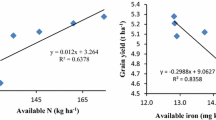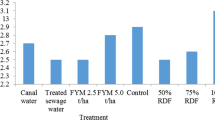Abstract
Field experiments were carried out at the research farm of ICAR-Indian Agricultural Research Institute (ICAR-IARI), New Delhi, India, during Kharif (June–October) seasons of 2011 and 2012 to study the effect of rice varieties and iron fertilization on water productivity, nutrient uptake and quality of aerobic rice. Treatments comprised of two rice varieties (PRH-10 and PS-5) and eight sources and modes of iron fertilization—control (no iron), iron sulphate @ 50 kg/ha + one foliar spray of 2.0% iron sulphate, iron sulphate @ 50 kg/ha + one foliar spray of 0.5% iron chelate, iron sulphate @ 100 kg/ha, two foliar sprays of 2.0% iron sulphate, three foliar sprays of 2.0% iron sulphate, two foliar sprays of 0.5% iron chelate and three foliar sprays of 0.5% iron chelate. Study results indicated that variety PRH-10 had higher concentration and uptake of nitrogen, phosphorus, potassium and iron than PS-5 variety in grain, straw and grain + straw. Three foliar sprays of 2.0% iron sulphate or 0.5% iron chelate favoured higher NPK and iron concentration and uptake in grain and straw of aerobic rice. Grain quality in respect of hulling, milling and head rice recovery was, however, superior in PS-5 than PRH-10. But the protein content was significantly higher in PRH-10 than in PS-5. Application of three foliar sprays of 2% iron sulphate and three foliar sprays of 0.5% iron chelate recorded significantly higher hulling, milling and head rice recovery as compared to control and remained statistically similar with each other. Irrigation and total water productivity was substantially higher in PRH-10 over PS-5. Growing of rice with PRH-10 recorded ~7.7% higher total water productivity as compared to PS-5, across iron fertilizations. Three or two foliar sprays of 2.0% iron sulphate or 0.5% iron chelate favoured higher irrigation and total water productivity of aerobic rice over control (no iron).
Similar content being viewed by others
References
Anonymous (2013) 4th Advance estimate 2012–13, Ministry of Agriculture, Govt. of India
Bouma BAM (2001) Water efficient management strategies in rice production. Int Rice Res Inst Notes 16(20):17–22
Dass A, Chandra S (2013) Irrigation, spacing and cultivar effects on net photosynthetic rate, dry matter partitioning and productivity of rice under system of rice intensification in Mollisols of Northern India. Exp Agric. doi:10.1017/S0014479713000252
Fisher RA, Yates F (1963) Statistical tables. Oliver and Boyd, Edinburgh
Frossard E, Bucher M, Mächler F, Mozafar A, Hurrell R (2000) Potential for increasing the content and bioavailability of Fe, Zn and Ca in plants for human nutrition. J Sci Food Agric 80:861–879
Ghafari H, Razmjoo J (2015) Response of durum wheat to foliar application of varied sources and rates of iron fertilizers. J Agric Sci Technol 17(2):321–331
Gomez KA, Gomez AA (1984) Statistical procedures for agricultural research. In: An international rice research institute book, 2nd edn. A Wiley-Inter science Publication, Wiley, New York
Jackson ML (1958) Soil chemical analysis. Asian publication house, New Delhi, pp 173–195
Kumar V, Ladha JK (2011) Direct seeding of rice: recent developments and future research needs. Adv Agron 111:297–413
Lucena C, Romera FJ, Rojas CL, Garcia MJ, Alcantara E, Perez VR (2007) Bicarbonate blocks the expression of several genes involved in the physiological responses to Fe deficiency of Strategy I plants. Funct Plant Biol 34:1002–1009
Olsen SR, Cole CV, Watanabe FS, Dean L (1954) Estimation of available phosphorus in soil by extraction with sodium carbonate. U.S.D.A, Washington, p 933
Prasad R (2011) Aerobic rice systems. Adv Agron 111:207–247
Prasad R, Shivay YS, Kumar D, Sharma SN (2006) Learning by doing exercises in soil fertility (A practical manual for soil fertility). Division of Agronomy, Indian Agricultural Research Institute, New Delhi, p 68
Rengel Z, Batten GD, Crowley DE (1999) Agronomic approaches for improving the micronutrient density in edible portions of field crops. Field Crops Res 60:27–40
Sahai VN, Choudhary RC (1986) Root system in hybrid rice. Int Rice Res Newsl 11:13
Salgotra RK, Katoch PC, Sood M (2002) Performance of rice hybrids for yield and quality traits under mid-hill conditions of Himachal Pradesh. J Res SKUAST J 1:38–42
Souframanein J, Rangasamy P, Vaidyanathan P, Thangaraj M (1998) Heterosis under drought condition in hybrid rice. Oryza 35(2):120–123
Subbiah BV, Asija GL (1956) A rapid procedure for assessment of available nitrogen in rice soils. Curr Sci 25:259–260
Tuong TP, Bouman BAM (2002) Rice production in water-scarce environments. In: Kijne JW, Barker R, Molden D (eds) Water productivity in agriculture: limits and opportunities for improvement, vol 1., The comprehensive assessment of water management in agriculture seriesCABI Publishing, Wallingford, pp 13–42
Tuong TP, Bouman BAM (2003) Rice production in water-scarce environments. In: Kijne JW, Barker R, Molden D (eds) Water productivity in agriculture: limits and opportunities for improvements. CABI Publishing, Wallingford, pp 53–67
Vosenek LACJ and Van DVR (1994) The role of phytohormones in plant stress: too much or too little water. Acta Bot Neerlandica 43:91–127
Walkley AJ, Black IA (1934) An examination of the Degtjareff method for determination of soil organic matter and a proposed modification of the chronic acid titration method. Soil Sci 37:29–38
Yadav S, Gill G, Humphreys E, Kukal SS, Walia US (2012) Effect of water management on dry seeded and puddled transplanted rice. Field Crops Res 120:112–122
Yadav GS, Shivay YS, Kumar D, Babu S (2013) Enhancing iron density and uptake in grain and straw of aerobic rice through mulching and rhizo-foliar fertilization of iron. Afr J Agric Res 8:5447–5454
Yi XP, Chen FY (1992) Genetical effect of different cytoplasms on rice cooking, milling and nutrient quality of indica type hybrid rice. Chin J Rice Sci 6(4):187–189
Zeigler RS (2007) Rice and the millennium development goals: the International Rice Research Institute’s strategic plan 2007–2015. Paddy Water Environ 5:67–71
Author information
Authors and Affiliations
Corresponding author
Rights and permissions
About this article
Cite this article
Kumar, V., Kumar, D., Singh, Y.V. et al. Water productivity, nutrients uptake and quality of aerobic rice as influenced by varieties and iron nutrition. Paddy Water Environ 15, 821–830 (2017). https://doi.org/10.1007/s10333-017-0595-x
Received:
Revised:
Accepted:
Published:
Issue Date:
DOI: https://doi.org/10.1007/s10333-017-0595-x




